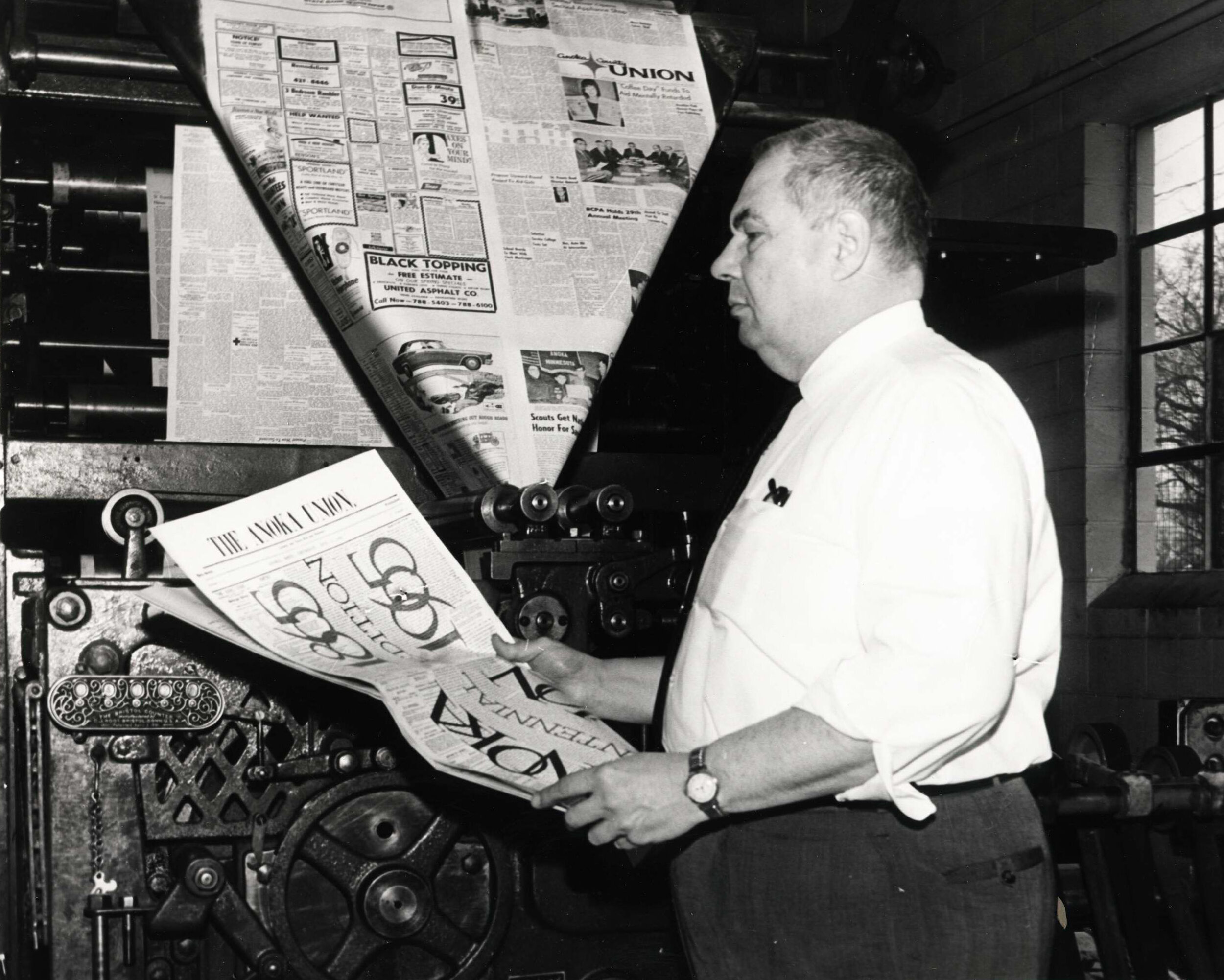History 21 The Podcast - 1.03 Arch Pease Newspaper Man
Local newspapers are a bedrock of historical research, but those documents are created and run by people in the community. Listen to an interview with Arch Pease, editor and owner of the Anoka Union from 1946 until 1989, as well as it's with it's descendants Managing Editor, Jonathan Young.
Hosts Rebecca Desens, ACHS Executive Director and Sara Given, ACHS Volunteer Coordinator.
Arch Pease and his mother Mrs T.G.J. [Mary] Pease in the old Pease Printery office, circa 1920s. Object ID: 2075.1.18
Arch Pease
September 25, 1908 - September 28, 1990
Manager, Editor, and Publisher Anoka County Union 1946-1989
“[Arch Pease] was a graduate of the Anoka, Minnesota, high school [1925] and the University of Illinois, Class of 1931. During his high school days he was a sportswriter, bookkeeper, printer’s devil, handyman, janitor, newspaper salesman, and general newsman on the Anoka County Union, one of Minnesota’s pioneer weeklies. Following graduation from Illinois, he taught seven years in senior high schools in southern Illinois, 3 1/2 years in Minnesota high schools and left the teaching field in 1940 to become a Congressional secretary. During his teaching years he taught English, geography, mathematics, physical education, and was a head as well as assistant coach in football, basketball, track, tennis, baseball plus dramatics such as coaching school plays and heading speech instruction. After two years as a Congressional secretary, he was called into service as a 1st Lieutenant early in 1942 and was discharged on his return from the Philip[pines in 1946 as a Lt. Colonel. He is a graduate of the Command and General Staff School at Fort Leavenworth, Kansas, and retired after 32 years with the Reserves on January 2, 1962 in the grade of Colonel. He has served as President of his Chamber of Commerce in Anoka, as President of the Minnesota Newspaper Association (1961) and as President of the Minnesota Press Club (1962).”
Preface to “Memories of Life…” by Arch G. Pease.
History 21: The Vault Extras
Listen to Arch Pease’s full oral history interview
Read Arch Pease’s “Memories of Life…” memoir
Arch Pease by press holding 1965 (Centennial) edition. Object ID: 2075.8.35
Jonathan Young, Managing Editor ABC Newspapers.
Jonathan Young
is the Managing Editor at ABC Newspapers which includes the Anoka County UnionHerlald, Blaine/Spring Lake Park/Columbia Heights/Fridley Life and Anoka County Shopper.
The biggest way to support local news reporting that Arch Pease championed is to subscribe to your local newspaper. Find ABC Newspapers Here!
Anoka County Library Minute
Further Reading:
Interested in genealogy? You can learn a lot about your family and the times in which they lived by searching in historical newspapers. Use this book to learn how and where to look for this information, and then come to the library and use our resources to help you find it!
Coffee Made Her Insane: And Other Nuggets from Old Minnesota Newspapers by Peg Meier - 977.6 MEI
This book was written by Peg Meier, a longtime and award-winning journalist of the Minneapolis Star Tribune. It covers humorous, interesting, and weird ads and stories from Minnesota newspapers from the 1840s to the 1940s – one Goodreads reviewer calls it “100 years worth of wonderfulness”!
Newspapers on the Minnesota Frontier, 1849-1860 by George Sigrud Hage - MR071 HAG
Former U of M journalism professor George S. Hage wrote this book about the beginnings of newspapers in Minnesota. Covering the years 1849-1860, the book looks at the first newspapers in St. Paul and its then rival, St. Anthony, the development of daily and weekly newspapers, and controversial changes like the incorporation of railroads and how they were reflected in the news. This book is part of our Minnesota Reference collection and cannot be checked out, but it can be viewed in the library or photocopied.
Anoka County Union: Your Souvenir Bi-Centennial Issue -
This special bi-centennial edition of the Anoka County Union newspaper celebrates and was released in honor of the bi-centennial of the United States of America in 1976. Large, bound copies of this souvenir newspaper are available for browsing in the Minnesota reference collections at Northtown and Rum River branches, and while they cannot be checked out, they can be photographed or used inside the library (they are probably too big to easily copy).
There are lots of newspapers and other goodies available on microfilm at the Anoka County Historical Society, but Anoka County Library also has local papers from the Anoka County and Twin Cities areas available for viewing at the Northtown Library. These films contain newspapers from the 1960s to the late noughts.
Minnesota Digital Newspaper Hub
The Minnesota Digital Newspaper Hub is provided by the Minnesota Historical Society and covers historical Minnesota newspapers from 1856-1924. This database provides full size scans of the newspapers in question.
Use the Minnesota Newspapers database from NewsBank to look at editions of newspapers from the Duluth News-Tribune, the Rochester Post Bulletin, the St. Paul Pioneer Press, and the Star Tribune. Some have issues back to the 80s, but all have current and recent issues posted here. These are most often transcriptions of the original newspapers.
Along with these databases on Minnesota newspapers, we also have newspaper databases for specialties like business, databases on Latin American journals, and online access to newspapers like The New York Times and The Wall Street Journal. And don’t be afraid of materials like the microfilm reader or the databases – we are always ready and willing to help you learn how to use these!

![Arch Pease and his mother Mrs T.G.J. [Mary] Pease in the old Pease Printery office, circa 1920s. Object ID: 2075.1.18](https://images.squarespace-cdn.com/content/v1/5c7599c5f4e5310b4740b63d/1609357478127-JT02R6RZUZNVZATWR7SU/2075.1.18.jpg)

